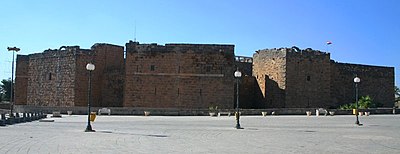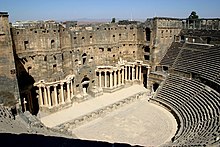Citadel of Bosra
The Citadel of Bosra is an almost completely preserved Ayyubid fortress in the Syrian city of Bosra . It was built around a Roman theater .
history
The city's citadel has an unusual history. Its origins date back to the late 2nd century AD when the city's Roman theater was built with up to 9,000 seats. After it was no longer used as a theater, all portals were probably bricked up in Umayydic times. To Abbasid time it was used, according to documentary tradition as a refuge. A proper expansion to a citadel only took place in the Seljuk period, after they had conquered Damascus and the surrounding area in 1076 . According to a building inscription, the two staircases at the corners were raised to form towers. By this time at the latest, all openings that contradicted the new defensive character of the structure will have been blocked. In 1147/48 a tower was built on the southwest side. A gate tower, which no longer exists today, was probably built on the northwest corner. The buildings show typical features of the building method of the region around Bosra, the Hauran . Numerous spoils indicate the origin of the building material from the ancient city. Further modifications to the citadel can be assumed, but were repaid by the subsequent construction phases.
The second phase of expansion of the citadel from 1202/03 coincides with the consolidation of the Ayyubid Empire under Saladin's brother al-Adil Abu Bakr . A total of eight towers were built at a sufficient distance from the theater. After the death of al-Adil in 1218 his son al-Salih Ismail resided in Bosra. The citadel served as a stately residence until 1246. The interior of the theater was also expanded for this purpose. Around 1240 a glacis was placed in front of the outer wall .
The reconstruction measures, which amounted to a new construction of the fortification, represent a turning point in the fortification system. With the advent of better slingshots, the walls were built stronger and lower in order to be able to withstand this attack better. The shell masonry and the vaulting technique differ greatly from the Hauran construction method and suggest Damascus builders.
During the first Mongol storm in 1260, the citadel was surrendered without a fight. After the victory over the Mongols and the conquest of the country, the Mamluck sultan Baibars had the rifled parapets repaired. He put a garrison in the fortress, which from now on controlled the area. The garrison continued to exist during the Ottoman era and in 1897 was several hundred men. In the 20th century, the Syrian antiquities administration stopped further decline. From 1946 to 1970 all medieval fixtures were removed.
literature
- M. Meinecke, F. Aalund, L. Korn: The Citadel in Bosra - Islamic Architecture and Archeology, Orient-Archäologie 17, Rahden, Leidorf 2005.
Coordinates: 32 ° 31 '4.3 " N , 36 ° 28' 54" E



